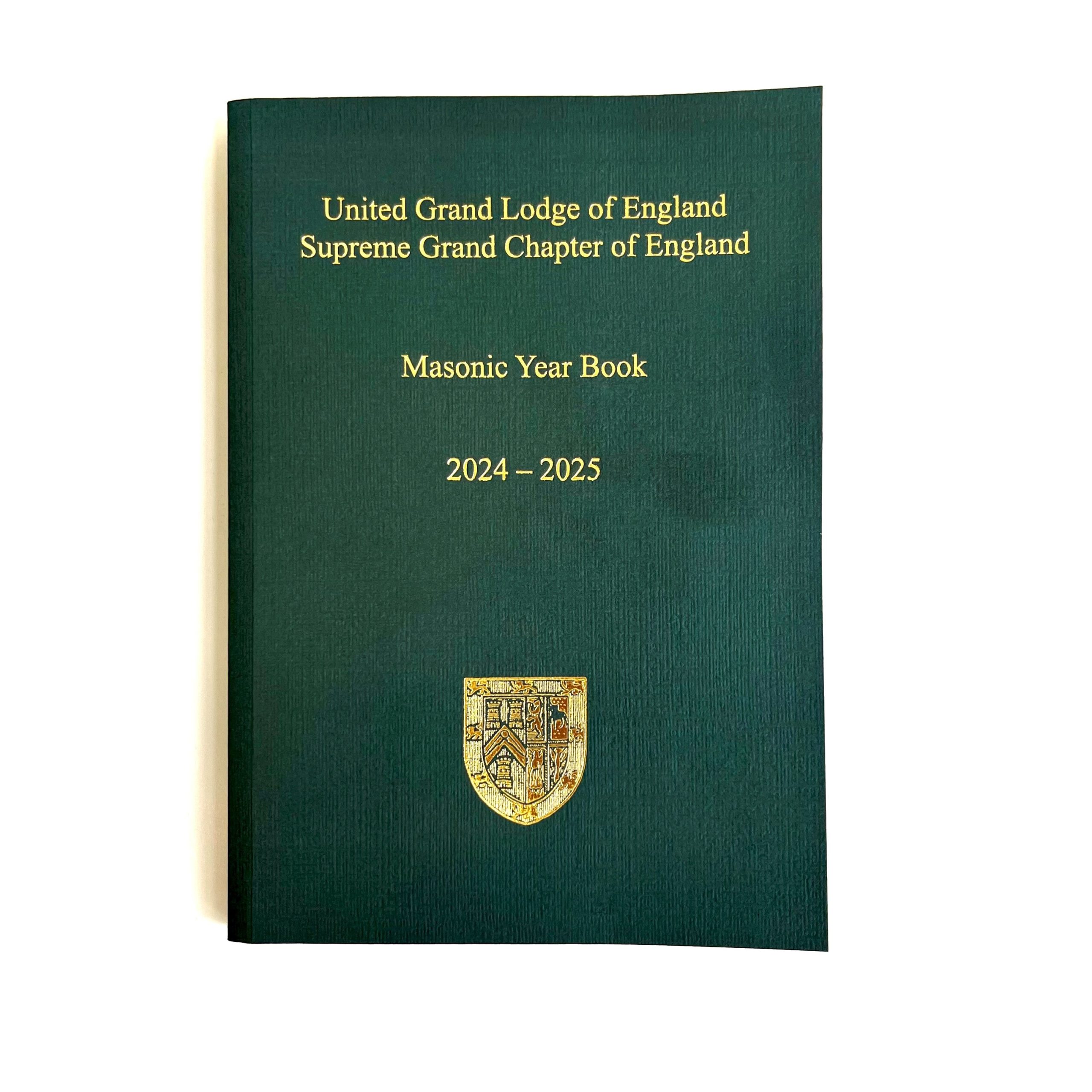Masonic Yearbook 2024/2025
$15.00
The new Masonic Yearbook for 2024-2025.
Description
The new Masonic Yearbook for 2024-2025.
Reviews (0)
Be the first to review “Masonic Yearbook 2024/2025” Cancel reply
Shipping & Delivery
Related products
1723 Constitutions
$12.00
Three Hundred Years Ago In the year 1723 a book was published that laid out the principles and aims of English Freemasonry. Ideas that included social equality, religious tolerance, self-improvement, reward and advancement for merit, charity and goodwill to all. These ideas were radical and challenging in a time characterised by religious conflict and when birth and wealth determined success and often even survival. This fascinating and beautiful book also provided a framework for Freemasonry, a rulebook that would be emulated by many other secular clubs and societies in Britain and around the world. Masonic practices introduced in the 1723 Constitutions include the election of officers subject to democratic accountability, with one member wielding one vote; majority rule; orations by elected officials; national governance; and written constitutions. Introduced by a beautiful symbolic frontispiece, this work was not just practical, but also inspirational, containing a traditional history of Freemasonry and many Masonic songs. Rich with Masonic insight and symbolism, there is as much to be found in this work for modern Freemasons as there was the day it was published. This book contains a faithful reproduction of the first edition of the Constitutions of the Free-Masons, printed in London in 1723. The text, word spelling and paragraph size has been maintained, original restored decorations have been used, and font and character typesets have been carefully replicated. The cover border and central design have been carefully reproduced from original copies in the archives of the Museum of Freemasonry held at the United Grand Lodge of England. Paperback 109 Printed Pages
Freemasonry in London from 1785
$19.99
This book is a well-researched study by a competent masonic scholar who has welded links from the changing scenes that arose in an era in which the most important step forward in organised Freemasonry was taken, the masonic Union between the two Grand Lodges in 1813, and from the events that followed. As a vehicle for his survey the author chose an Antients lodge which was formed by Dispensation in December 1785 at The Ship Tavern, situated at the junction of Gate Street and Little Turnstile, off Lincolns Inn Fields. It was constituted in February 1786 by Laurence Dermott, probably the most outstanding character in the history of Freemasonry in determining the course to be steered, who fancied those brethren Warrant No 234. That lodge on that night took the name Domatic, and on the subsequent renumberings and closing-up of the Registers now take their place as No 177 on the Register of United Grand Lodge of England. Whilst the records of the Domatic Lodge. their Lodge of Instruction (AD 1808), their Royal Arch Chapter (AD 1793), and Chapter of Instruction (AD 1850) provide terms of reference and an ordered sequence the book is not intended to be taken as a history of that group. Personalities arise throughout the account and it is from the examination of their behaviour and activity that the reader will be enabled to appreciate the modus Operandi and the emergence of things masonic, also to understand the difficulties of that age. The human element bursts into various scenes and events and it is the authors treatment that converts the factual into the fascinating and makes for such absorbing reading. He takes notes of the various qualities and failings that one would expect to find in any large organisation, but, as he has stated, this time they have been clothed with a Masonic apron! Although it is a progressive account of the development of Freemasonry with such interesting aspects it is also a book of reference and a guide to further information if a study of a particular facet of Freemasonry is desired, and for that reason it will undoubtedly take its place among the important masonic publications. Format : Hardback Page : 176 Size : 247 x 190
Over 300 Years of Masonic Ritual
$15.00
This book celebrates the 300th anniversary of the founding of the Premier Grand Lodge in June 1717, by reviewing the basis of our workings from the earliest records to the formation of the United Grand Lodge of England in December 1813 and further. It addresses such important questions as what is the craft of Freemasonry and where did it come from, how was it practised from 1200 to 1700 and much more.
The Acacia Book
$20.00
The 2024 Edition has been improved based on feedback from Brothers like you around the world. [ NEW IN 2024 ] More Lodges and Grand Lodges: Freemasonry is continuing to grow around the world. We've added five new Grand Lodges to The Acacia Book, and hundreds of new Lodges. We've also removed Lodges that closed or merged, so you can be sure that you're looking at the most up-to-date list possible. [ NEW IN 2024 ] More Masonic Conferences: We've nearly doubled the number of Conferences listed, both in the overview section and in each Grand Lodge's profile. [ EXPANDED ] More Masonic Education: You loved the quotes, info, and pictures we added to The Acacia Book... so we added more! This book isn't just a reference, it's a chance to learn more about the Craft around you. Do you have something to submit for future editions? Send us a note at support@copiri.com! Of course, these updates just add to what already makes The Acacia Book a requirement for every Secretary's desk. The 2024 edition still includes: Global Recognition Roster: The Grand Lodges of the World section shows every Grand Lodge that is recognized by one other Regular Grand Lodge, and whether you recognize them or not. With over 300 Grand Lodges listed, it's never been easier to find your visitor's. Quick-Find Country Codes: Skip the table of contents... we've added country codes to the page headers so you can flip through quickly and stop exactly where you need to be. Remember, the codes may not be in the order you expect... see the list of UN Country Codes at the back of the book for details. Grand Lodge Seals: It's not always easy to tell Grand Lodges apart by their names... so we've added seals to each profile. As a bonus, this is also one more way to check your visitor's dues card! Quick-Launch QR Codes: We all know the truth... this book is out of date as soon as it's printed. Updated info is always in the Amity app, though... so we've added a QR code to each Grand Lodge profile to help you get there quickly. Just scan a Grand Lodge's code, and Amity will show you all of its active Lodges. Lodges in Numerical Order: We know you use this book for testing visitors, not finding Lodges to visit... so we've sorted the Lodges by number to help your search. One More Reminder... no matter what you read in this book, your Grand Secretary is always the final say on matters of recognition.
The Regius Poem – Bilingual Edition in Modern and Middle English
$40.00
Freemasons throughout the world are finally able to study a six-hundred-year-old manuscript of The Old Charges thanks to an unprecedented translation in modern English that has preserved the original rhyme scheme . For these Brothers, it may provide new and meaningful insight into the history of the Craft from a medieval perspective, which is more about the actual do s and donts for ancient stonemasons than tod ay s Brotherhood and its symbolism. Nonetheless, it offers a lot of recognition when it comes to the origin of modern Masonic practices. Ever since James Halliwell (1820 1899) discovered The Regius Poem in 1842, English-speaking Masons have had to make considerable effort to cope with its language, which dates back to approximately 1425. Until now, the manuscript could only be read in its original wording, in modern prose or in attempts that failed to qualify as poetry. This implies that, in actual practice, the earliest document of The Old Charges has mostly been appreciated for its wisdom and strength - at the expense of its beauty. To reinstall this trinity, Brother Harry G. de Vries has translated the old text from rhymed Middle English to rhymed Modern English for the first time. It was his aim, he says, to facilitate his English-speaking brothers with a version in which the essential literary ingredient of rhyme would be revived in order to rekindle the poem's 600-years-old beauty. As a result, it helps bring today's Masons much closer to the impact the poem would have had on its medieval audiences. In the foreword, the Dutch author explains why being a native speaker of Dutch may have been a considerable help to understand and translate the language of The Regius Poem. You can check the results of his labour in this edition, in which each left-hand page has the original text and each right-hand page displays the modern translation. Brother Harry takes you back to a medieval lodge where a travelling word artist served masons the history of their craft as it was seen at the time - after the day's work had ended. At Lewis Masonic we are sure that this unique version in rhymed modern English will provide Freemasons with a new perspective on the beauty of their Craft. Limited Edition of 500 only Printed on Artisanal Textured Italian Paper Cloth Bound Beautiful End Papers 152 pages 168 x 240
World of Freemasonry
$20.00












Reviews
There are no reviews yet.